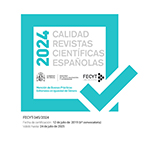Envíos
Lista de comprobación para la preparación de envíos
Como parte del proceso de envío, los autores/as están obligados a comprobar que su envío cumpla todos los elementos que se muestran a continuación. Se devolverán a los autores/as aquellos envíos que no cumplan estas directrices.- La revista solo acepta envíos por email a: reem@ucm.es
- El envío de un documento a esta revista supone la aceptación de la Declaración de originalidad y autoría. Descargar documento
- El fichero enviado está en formato OpenOffice, Microsoft Word, RTF, o WordPerfect.
- Se han añadido direcciones web para las referencias donde ha sido posible.
- Se han añadido las referencias DOI en los casos en que existen.
- El texto cumple con los requisitos bibliográficos y de estilo indicados en las Normas para autoras/es, que se pueden encontrar en Acerca de la revista.
- Si esta enviando a una sección de la revista que se revisa por pares, tiene que asegurase que las instrucciones en Asegurando de una revisión a ciegas) han sido seguidas.
Aviso de derechos de autor/a
La revista En la España Medieval, para fomentar el intercambio global del conocimiento, facilita el acceso sin restricciones a sus contenidos desde el momento de su publicación en la presente edición electrónica, y por eso es una revista de acceso abierto. Los originales publicados en esta revista son propiedad de la Universidad Complutense de Madrid y es obligatorio citar su procedencia en cualquier reproducción total o parcial. Todos los contenidos se distribuyen bajo una licencia de uso y distribución Creative Commons Reconocimiento 4.0 (CC BY 4.0). Esta circunstancia ha de hacerse constar expresamente de esta forma cuando sea necesario. Puede consultar la versión informativa y el texto legal de la licencia.
La revista En la España Medieval no cobra por tasas por envío de trabajos, ni tampoco cuotas por la publicación de sus artículos.
Declaración de privacidad
Información básica sobre la actividad de tratamiento: Servicio de Publicaciones
| Responsable | Vicerrectorado de Cultura, Deporte y Extensión Universitaria +info |
| Finalidad | Divulgación, venta, facturación y envío de publicaciones +info |
| Legitimación | Misión en interés público; ejecución de contrato +info |
| Destinatarios | No se cederán datos a terceros, salvo obligación legal +info |
| Derechos | Acceder, rectificar y suprimir los datos, así como otros derechos, explicados en la información adicional +info |
| Información adicional |
Puede consultarla con detalle en nuestra página web: |











